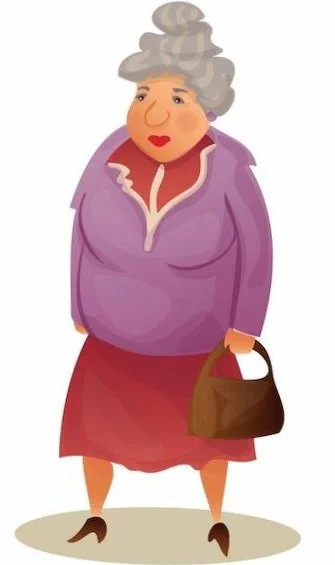Aging gracefully, or else...
/One of my online coaching clients — I’ll call her Sally — is 85 years old and has fallen in the street several times. Watching her walk, it’s easy to see why she falls. Her legs rotate outward to about 45 degrees and her feet are set wide apart—beyond her torso. For each tiny step forward, she tilts her whole body sideways. With stiff ankles, knees, and hips, her movement has a puppet-like quality.
The wide stance feels stable to Sally when she’s standing still, but any movement threatens to topple her forward or back, even when she uses her walking sticks.
Sally hates catching glimpses of herself in store windows. My posture has gotten so awful, she says. I look like a turtle.
Be a majorette instead!
You might think this woman could simply bring her feet under her torso and turn her thighs inward to align the knees. Then — shoulders back, head up, and she’s good to go. One of Sally’s coaches, a “gait specialist”, had tried to make her do just that. She was supposed to practice marching proudly, like a drum majorette.
In my experience people don’t change deeply held movement patterns by switching to a new choreography. Rather than lay a new pattern on top of the one that isn’t working, I try to help my clients discover the underlying habits that dictate dysfunctional movement. Then they try to sense the habit’s purpose: what is it attempting to accomplish? Usually, in some odd way, it’s trying to maintain safety and support. Once a client can understand that, and truly feel what she’s doing, then she can begin to develop a better habit that will serve the same purpose.
It took a number of lessons before Sally realized the extent to which she was contracting and gripping the muscles at the base of her buttocks.
The pelvis controls the show.
When the coccyx is drawn down and forward (narrowing the posterior triangle of the pelvic floor), the entire pelvis tilts backward. This changed pelvic inclination also changes the angle of the hip sockets in a way that makes the thighs rotate outward. The posterior tilt of the pelvis also brings the weight of the whole body back onto the heels. To keep from falling backward the structure compensates by folding the spine and/or neck forward. This was the posture that Sally so hated seeing in the mirror. She’d been an actress on Broadway! Now—although she wouldn’t put it this way—she suffered from some very common and very unglamorous biomechanical inevitabilities.
Oh, she said, I’m clenching my butt all the time!
That was it in a nutshell. Tension around the root chakra, the yogic center that represents the security of one’s existence, is not uncommon among the elderly—dear old folks who quite reasonably fear a fall, likely also suffer from the gaseous results of declining digestive efficiency. None of us wants to fart in public.
Walk like Gypsy Rose Lee.
Little by little, step-by-step, Sally discovered that by softening her “rear end” she could stand up straighter, bring her legs more directly beneath her body, and recover mobility in her hip joints. She practiced slowly transferring her weight from one hip joint to the other, taking time to enjoy the sensation in each hip.
I wondered whether Sally’s history as an entertainer might be a resource for her, so I invited her to tap into it. One Sunday morning she walked with the hips of a showgirl — a charming thing to witness. But she could only do it when she moved slowly enough to stay conscious of the sensations in her hips and feet. This was the hardest part—she didn’t want to slow down.
I’m always in a hurry, she told me. And I’m always late. People get so mad at me when I’m late for my appointments.
How old are these people—your Pilates teacher, your physical therapist? They’re young right? Under fifty?
They have no idea what it feels like to be 85!
Next time you’re late, tell them you’re doing them a favor: you’re helping them practice patience.
I’ve been trying to convince Sally that eventually she’ll be able to speed up without clenching—that she can gradually accelerate her safer, more efficient (and more graceful) way of walking. But for or a month or more she needs to be content to go slowly.
You’re too old to be in a hurry, I tell her.
That last sentence echoed in my mind for several weeks while I was in my own hurry to bypass some challenges. But the older one becomes; the fewer shortcuts seem to be available. Maybe shortcuts were never really workable and now their cost is just impossible to deny. Like Sally, I have to be content to go slower and to let my to-do list gather dust. Now who needs that lesson in patience?
Last Sunday Sally fell when getting out of bed. She’s in a care facility now, recovering from surgery for either a broken hip or a broken leg. Her email wasn’t clear.
I’m sad about the pain she’s going through; sad about how this incident isolates her. And disappointed that neither of us can have the happy ending I had been anticipating. Not just yet.
© 2022 Mary Bond


